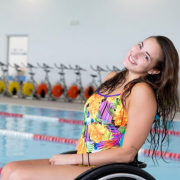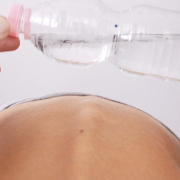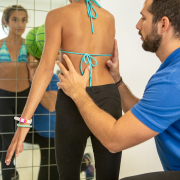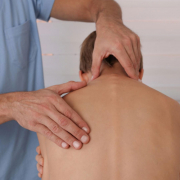Gym workouts and scoliosis: can the two go hand in hand?
In recent years, fitness has become a booming industry, driven by a growing interest among young people and on social media. This trend has resulted in the emergence of better-qualified fitness professionals, triggering a virtuous circle in terms of improving the quality and safety of training.
From our perspective, it is worth remembering that physical activity, if performed correctly, can have a protective role in the management of scoliosis.
We are often asked whether patients with scoliosis, particularly those undergoing bracing treatment, can work out in the gym.
Before answering this question, let’s make two things clear:
● the literature contains nothing specific on this topic;
● “working out in the gym” means more than one thing (i.e., not all training is the same).
The importance of goals
Before embarking on a training programme, it is crucial to establish your personal goals. Among adolescents, the main reasons for working out are often the desire to build muscle (boys) or tone up (girls). However, in adolescence, learning the correct training techniques and improving your physical abilities, such as coordination, balance, strength, and resistance, are more important than immediately seeking to bulk up your muscles.
Young people will find that efforts to gain muscle mass give more gratifying results once they have finished growing (i.e. after reaching 16-18 years of age).
The best approach, then, is to try to focus on what you actually do in the gym, striving to do it better and more effectively and thinking less about what you see in the mirror.
The benefits of training in the gym
Training in the gym offers you the chance to monitor your body and safely regulate training stimuli, unlike when practising many competitive sports, during which you are more likely to sustain an injury. Several studies show that the gym is associated with a lower injury rate than other sports.
Advice for those with scoliosis
We should first point out that young people with scoliosis (boys and girls) are, in most cases, no different from their peers who do not have scoliosis. Having said this, we do have some advice.
- Find a professional. A properly qualified trainer can help you do the exercises correctly and adapt the training programme to your individual requirements. It might also be a good idea to put your doctor/physiotherapist and trainer in contact with each other, so that the training programme can be refined and any doubts addressed.
- Don’t be in a hurry. Targeted warm-up exercises can improve flexibility and reduce stiffness in the spine.
- Choose your exercises. It is important to start with simple and controlled exercises, then gradually increase the difficulty level.
- Take care with axial loads. Axial loading exercises must be performed carefully to avoid sudden or compensatory movements. When it comes to the squat, for example, the goblet squat may be the best option as it is performed with the weight (dumbbell/plate/kettlebell) held in your hands, at chest height, in front of you. By facilitating load management, this version guarantees greater stability and makes it easier to control the movement.
- Learn to “dose” self-correction. When you are working out in the gym, the amount of self-correction you apply (i.e., the extent to which you adopt the position designed to counteract the scoliotic curves and therefore keep your spine more aligned) will depend on the type of exercise you are doing and the level of fatigue you are experiencing. The objective of exercises done in the gym differs from that of the specific exercises taught you by your physiotherapist, where self-correction is the key element, and determines how the exercises are performed. When you are using weights, the priority is to focus on the specific training stimulus, while at the same time trying to keep your spine properly supported.
Should a brace be worn in the gym?
Individuals who are being treated with a brace can consider doing their physical activity during their brace-on hours, so as to take full advantage of the support provided by the brace itself. However, if they prefer to train during their brace-off window, they should make sure they do a longer warm up, so as to prepare their back for the training session.
So, finally
Working out in the gym is possible for those with scoliosis and can indeed be beneficial if the necessary precautions are taken. Be sure to find a professional trainer, keep your doctor in the loop, and listen to your body because these are the keys to safe and effective training.











Leave a Reply
Want to join the discussion?Feel free to contribute!